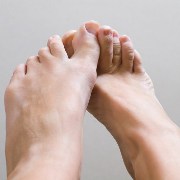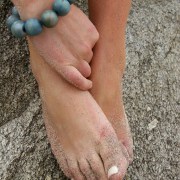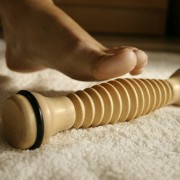 Photo: Getty Images
Photo: Getty Images
Inflammation of the plantar fascia is called plantar fasciitis. The plantar fascia is thick tissue on the bottom of the foot connecting the toes to the heel bone, and forming the arch.
When the plantar fascia is overused or stretched too far, walking can become difficult and pain can be the result. Plantar fasciitis is a common source of heel pain.
Long-distance runners, ballet dancers and those who participate in dance aerobics are at higher than normal risk for plantar fasciitis. This is due to the ongoing, intensive stress of activity, burdening the heel and surrounding tissue.
People who are on their feet, on hard flooring, during their work day also have a higher risk for plantar fasciitis. This includes teachers, store clerks and factory workers.
People between 40 and 60 years of age are at highest risk for developing plantar fasciitis.
Plantar fasciitis is more likely to occur to individuals who have flat feet, unusually high arches or extremely tight Achilles tendons. The Achilles tendons connect the heel bone to the calf muscles, aiding in walking, jumping and running.
Plantar fasciitis can be brought on by running long distances over uneven surfaces, or running downhill. Plantar fasciitis pain usually comes on gradually. While it can affect both feet, it's more commonly found in one foot only.
Healthy plantar fascia provides support to the arch, similar to a shock absorber. With plantar fasciitis, small rips can appear in the tissue. Inflammation can be the result of stretching that is repetitive.
How do you know if you have plantar fasciitis? You may experience dull or sharp pain, or stiffness in your heel, or an aching or sense of burning in the sole of your foot.
Pain from plantar fasciitis tends to be more intense in the morning before you do any walking. Standing or sitting too long, or climbing the stairs can make pain more severe.
Shoes that don't offer adequate arch support, or whose soles are too soft can leave an individual more prone to plantar fasciitis. Putting on extra weight in a short time can contribute to a higher risk for plantar fasciitis.
How can you protect yourself from plantar fasciitis? To lower your risk for plantar fasciitis, wear shoes that have sufficient padding and offer good arch support. Avoiding high heels on a regular basis can protect your Achilles tendon from shortening and tightening, and straining the tissue of the plantar fascia.
Sources:
Plantar fasciitis. Ncbi.nlm.nih.gov. Feb. 19, 2011. Retrieved Oct. 31, 2011.
http://www.ncbi.nlm.nih.gov/pubmedhealth/PMH0004438
Plantar fasciitis. Mayoclinic.com. Retrieved Oct. 31, 2011.
http://www.mayoclinic.com/health/plantar-fasciitis/DS00508
Plantar fasciitis: Symptoms. Mayoclinic.com. Retrieved Oct. 31, 2011.
http://www.mayoclinic.com/health/plantar-fasciitis/DS00508/DSECTION=symptoms
Plantar Fasciitis: Causes. Mayoclinic.com. Retrieved Oct. 31, 2011.
http://www.mayoclinic.com/health/plantar-fasciitis/DS00508/DSECTION=causes
Plantar Fasciitis: Risk Factors. Mayoclinic.com. Retrieved Oct. 31, 2011.
http://www.mayoclinic.com/health/plantar-fasciitis/DS00508/DSECTION=risk-factors
Achilles tendinitis. Nlm.nih.gov. Retrieved Oct. 31, 2011.
http://www.nlm.nih.gov/medlineplus/ency/article/001072.htm
Visit Jody's website and blog at http://www.ncubator.ca and http://ncubator.ca/blogger
Reviewed November 1, 2011
by Michele Blacksberg RN






Add a Comment2 Comments
As this honorable notion has turned out to be all the more a test than we foreseen, I'd jump at the chance to impart a couple of lessons we've studied along the way. In this post I'll discuss lesson number one: the imperativeness and practice of an objectives based procedure seo zen, seo zen review, cpa tycoon, covert viral wizard review, cpa tycoon review
September 18, 2013 - 11:18amThis Comment
Hi
November 2, 2011 - 8:27amI have plantar fasciitis myself for a few months now. My podiatrist prescribed me with Custom made orthotics which did not work at all. I understood that treatment efficiency is very individual. If something works for one maybe it will not work for the other. I have found Taping very useful.
Today as I am feeling much better with the pain I am doing a combination of stretching and strengthening exercises. I have found a good website summary explaining the subject of these exercises in:
http://www.plantar-fasciitis-elrofeet.com/plantar_fasciitis_exercises.html
Take care & Good luck
This Comment